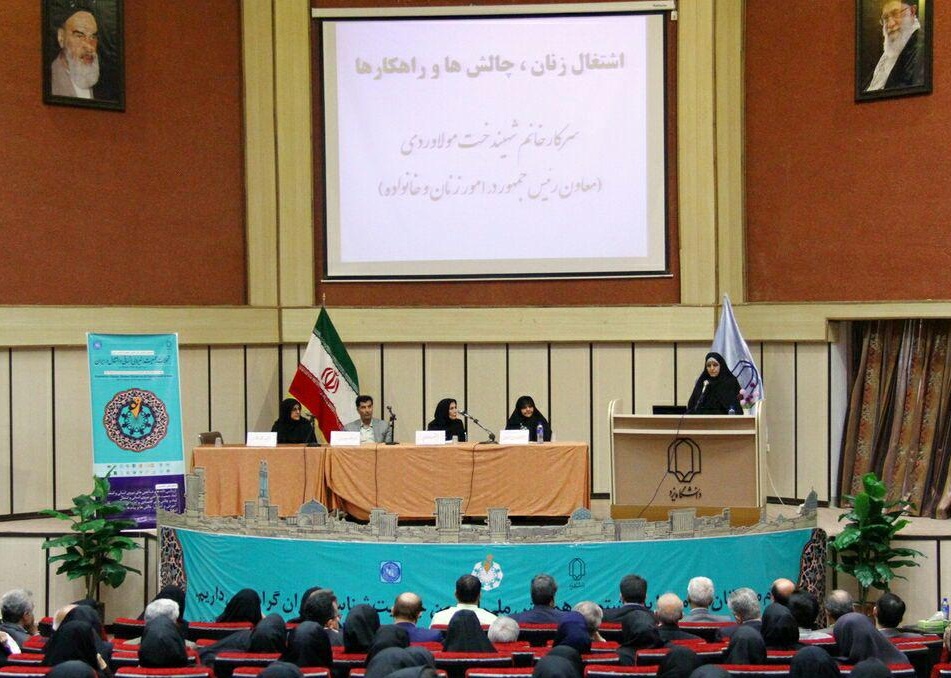The rate of economic participation of Iranian women is one of the lowest in the world, said Vice President for Women and Family Affairs.
“Iran ranks 141 among 145 countries in the latest Gender Gap Report of the World Economic Forum,” said Shahindokht Molaverdi at a specialized panel organized in Yazd city on Friday attended by a number of elite and entrepreneur women from Yazd Province, IRNA reported.
Noting that women’s employment is a persisting concern for the Rouhani government, she said a bill proposing a comprehensive support package for working women is being drafted at the Vice Presidency.
Increasing women’s economic participation rate through services that empower them is on the agenda,” she stressed.
Women students in Iran outnumber men at universities by two to one since the past few years, but when they graduate they are one-third less likely to be in the workforce as men.
In September 2015, Molaverdi cited Iran’s top economic challenge as unemployment and said it is particularly high among university-educated women and single mothers.

She stressed that despite the rise in the number of women with higher education, the country has not been successful in absorbing them into the workforce, underlining that more than 40% of women with higher education are unemployed.
“Proper management and laying the appropriate social and cultural groundwork are essential to make optimum use of the existing potential, keep pace with demographic changes, and turn the challenges into economic opportunities,” she said.
Unofficial Economic Sector
Molaverdi also mentioned that more and more women are driving the unofficial economic sector.
“Being a woman makes it easier to be employed in informal jobs,” with less pay and benefits such as insurance, she noted.
Technically, 87% of the female population is economically inactive and only 3 million are employed. Even if we consider “unofficial jobs” the figure doesn’t exceed 20%. Iranian women comprise 49.62% of the 80 million population.
There are various forms of gender discrimination in economic, educational and political arenas. There is disparity in the salary of women and men doing the same job and on the same level of productivity; also there is gender bias in the hiring process.
Preparing a national document on protecting women against violence, making efforts to remove gender bias in recruitment at state organizations, and the policy document on creating sustainable jobs for women with a priority for female university graduates in underdeveloped areas are also being pursued under her watch.
Statistics show that participation of women in the labor market rose steadily in the 1997-2005, from 10% to 17%. However, the rate declined in 2005-2013, from 17% to 10%, under the two terms of the previous government.
But since President Hassan Rouhani came to power, the rate has increased about 2% and is forecast to grow in the coming years.
In July, Rouhani ordered the cancellation of the third Civil Service Examination due in September, citing “lack of justice in the employment process including the gender-based quotas”. Over 2,800 job opportunities in 12 state bodies were available.
Rouhani tasked the Management and Planning Organization with ensuring “women’s employment rights” by amending the gender-related quotas.
The order was issued upon the request of Molaverdi, who earlier this year had told the Financial Tribune that she had discussed with Vice President Eshaq Jahangiri about gender discrimination in the civil service exam.
Startup Jobs Promising
Meanwhile, the new world of startups shows promise for both educated girls and housewives who may also be breadwinners.
Official figures say the number of female-headed households has seen an upswing from 1.2 million in 1991 to 2.5 million in 2015, posting a 208% increase. According to the latest figures of the Statistical Center of Iran, nearly 70% of Iran’s science and engineering students are women, and Iran’s blossoming startup scene encourages them to be economically active.
“Despite accounting for 60% of first-year university enrollments, women have not been doing well in entrepreneurship due to lack of boldness to take risks,” Fatemeh Daneshvar, an official at the Tehran Chamber of Commerce had said at the first Startup Weekend for Women in Tehran held in September 2013 to help systematize encouraging female entrepreneurs to share ideas and networking.
Such programs held annually, must push women and give them the momentum and support they need to start getting more active in the business environment.
One such startup that has bloomed over the past three years is ‘Mamanpaz’, which offers home food to its online customers. Mamanpaz (literally ‘mom-made’) is a Tehran-based online food delivery service which offers home dishes to customers who prefer home cooking to canteen food or takeaways. It has grown fast from nearly 30 customers a day in 2013 to over 200 today.


